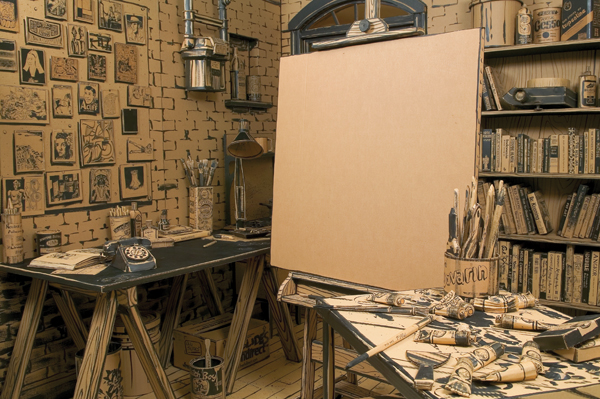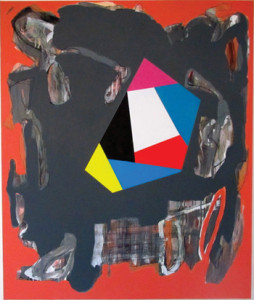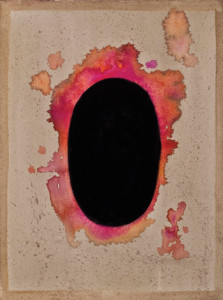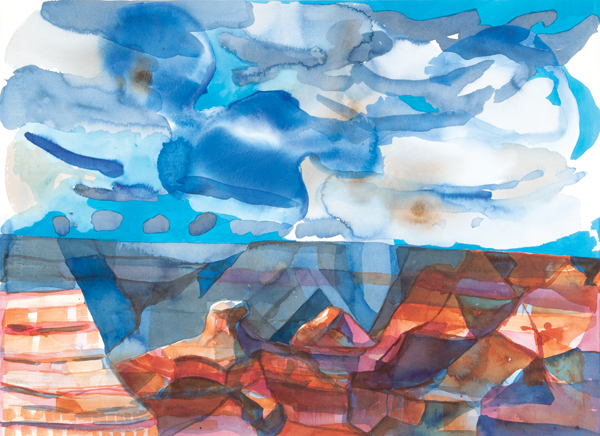Facing the Blank Canvas: Artists’ Tips for Getting Started
In Tom Burckhardt’s installation FULL STOP (2004–5), a large, empty canvas dominates a cluttered studio filled with books, paint tubes and brushes, sketches on the walls, and other paraphernalia of an artist’s working life. It’s a tour de force made entirely of cardboard; the whole thing has been shipped to such places as the Aldrich Contemporary Art Museum in Ridgefield, Connecticut, and DiverseWorks in Houston. It will be shown this fall at the Columbus College of Art & Design in Ohio.
The New York–based artist says the blank canvas in particular was his “response to feeling stuck with some of my painting, and not liking the way I was painting at the time, the way that everything was coming out so polite and well-mannered. Like every artist, I was starting to think, ‘Well, what if I’m going to be stuck, what if I can’t make anything else?’”

The empty canvas dominating Tom Burckhardt’s cardboard installation FULL STOP, 2004–5, expresses the artist’s recurrent fear of “feeling stuck.” COURTESY TIBOR DE NAGY GALLERY, NEW YORK
And that white slab of canvas, about 40 inches square, represents the terror many artists suffer before beginning a new project or body of work. Like an athlete, the artist requires downtime to recharge and gear up for new endeavors—and to forestall the panic of possibly not having the stamina or talent or inspiration to pull it off again. Tactics for filling up or emptying out before moving on can vary from the simple expedient of taking a vacation to months of reading to turning to a new medium, but one of the favorites seems to be the mundane task of cleaning out the studio.
Nene Humphrey is artist in residence at the Joseph LeDoux Center for Neural Science at New York University; her recent drawings and sculptures were inspired by the science of the brain. For years, she has been following the same ritual of thoroughly scouring her work space, a process that can take as long as a month.
“I start at the back of my studio. I get a big pail of hot water, some Mr. Clean, and a bunch of rags. I start at the top of the shelf nearest the door, and I slowly move my way up the room until everything is absolutely immaculate and orderly,” she says. “And then it’s so clean I have to do something again. I can start whatever’s been rummaging around in my head.”
Sculptor Don Porcaro turns to the same strategy, cleaning his tools and getting rid of “all traces of the last body of work. I consider it a form of meditation, a way of focusing and getting relaxed.” Some find that any meditative activity offers a way of emptying the mind in preparation for pursuing new endeavors. Painter Emilio Perez likes to go surfing between bodies of work, “to get rid of all that nervous energy, to get to a point where I can just focus on the work.”
Pat Steir was influenced by John Cage early in her career, and her practice is founded on meditation. “The size is predetermined, and in each case the colors are predetermined,” she says of her large-scale canvases. Because she considers her work grounded in performative actions, she envisions the kinds of movements she will make that will bring the pictures to life.
“Like the Japanese calligraphers, I meditate on the action,” she explains. “I mix the paint in big buckets, and then I sit in front of the canvases for a long time, maybe for an hour, sometimes as long as a month.”
For Steir, having many paintings going at the same time helps forestall any dread of not knowing what to do next. The same is true for Peter Plagens, whose life as both an artist and a critic means that he’s “always toggling between on and off, or ‘A’ and ‘B.’ Two hours at a shot is a long time in the studio for me,” he says, adding, “My wife has told me that I have the concentration span of a toddler.”

Artist and critic Peter Plagens works in groups of about six canvases at a time. A central motif composed of flat geometric shapes often plays a dominant role, as in untitled (red), 2013. COURTESY NANCY HOFFMAN GALLERY, NEW YORK
Plagens finds it useful to work in groups of about six canvases at a time, and to get started he turns to certain strategies in order to avoid what he calls his “mannerisms and pretty-making impulses.” For him, one way of getting started is to work late at night or when he’s tired, “so that it’s like drawing with your ‘off’ hand. Basically, it just involves haste and fatigue to get ideas off the ground.”
“Before I stand in front of the canvas, I make a big effort not to have an image,” says Enrique Martínez Celaya, a Cuban American artist who divides his time between Delray Beach, Florida, and Los Angeles. Martínez Celaya works in many different mediums. If he’s at work on a painting, “more often than not I like to break the whiteness of the canvas by doing something to it, not worrying so much if this is what I’m really after. I like to discover the painting in the act of painting itself.”
As an example, he cites his work The Surrogate (2014), a large picture of a solitary tree, which was painted over an image of a house. “All my paintings typically have three or four or five others underneath, but you very often don’t see that history in the work.”
Turning to an entirely different medium can also serve as a bridge to a new body of work. “I’ve been working on a series of gouache and acrylic paintings on paper with a single motif based on the Tantric lingam, an oval shape often used as a point of meditation,” says Leslie Wayne, whose last show at Jack Shainman Gallery, “Rags,” involved a labor-intensive process of building up layers of paint draped over an armature. “Usually one body of work morphs into the next, but I find that sometimes if I just sit down and start doing a few of these in the morning before I get going, that gets all the muscles moving.”
Sketching is another age-old activity for artists in their off hours, as a way of unwinding and of generating new ideas. When she visited the Grand Canyon last summer, Elisabeth Condon, who divides her time between New York and Tampa, Florida, and shows big abstract work at Lesley Heller Workspace in New York, made drawings and watercolors every day. “I would do small studies and draw for hours by the canyon and I would build those up into larger watercolors, and now I’m in the process of building those up into paintings.”
For Will Ryman, making sketches between large-scale installations may have nothing to do with the final product. “They’re never specific ideas, but they keep my hands moving, and that keeps me grounded creatively in some weird way and usually leads to connecting the dots between whatever concepts I’m thinking about and then whatever images I want to create three-dimensionally,” he says. “I do that for weeks and months sometimes. It’s a germination process.”

Leslie Wayne’s Lingam 2, 2013, is from a series based on the Tantric symbol of fecundity, an oval shape often used as a focus of meditation.©LESLIE WAYNE/COURTESY THE ARTIST AND JACK SHAINMAN GALLERY, NEW YORK
Given the growing popularity of the computer as part of the creative process, it’s not surprising that certain programs lend themselves well to sketching. Between bodies of work, Eric Fischl turns to Photoshop to work up new imagery. “That can take some time,” he admits, “which is good because I am still avoiding the blank canvas. When I have the image I want to work from, I print it out, and having done that I stand in front of the canvas, holding up the image and wishing I could just sneeze and the image would magically scale up and adhere to the canvas. But, unfortunately, I actually have to paint it.”
For many artists, reading offers a way to decompress between projects, and yet the books artists select may seem at first baffling choices. A few of Ryman’s preferred titles right now include Academic Capitalism and the New Economy: Markets, State, and Higher Education by Sheila Slaughter and Gary Rhoades, Noam Chomsky’s Media Control and How the World Works, and James Barrat’s Our Final Invention: Artificial Intelligence and the End of the Human Era.
“I’m interested in the psychology of our culture, specifically the psychology of capitalism,” Ryman says. Though installations such as The Roses (2011) and America (2013) may not at first appear to be overtly political, they are about taking “very simple truths and making them into complex objects.”
Similarly, Kathy Butterly’s bedtime reading may be a surprise, given the spirit of her whimsical and seductive ceramic sculptures: she was recently making her way through Herman Melville’s Moby-Dick. “Even reading just one or two pages,” she says, “it’s like looking at a great painting. That’s all I need at the moment—just to feel that passion in his word choices.”
For Julian Hatton, a painter who shows at Elizabeth Harris Gallery in New York, reading has provided a way of understanding his own processes. One of his favorite authors is Eric Kandel, a neuropsychiatrist and an expert on the subject of memory storage in the brain.
“After studying his ideas, I have a much better idea of what’s going on in my head, and why I don’t know if what I’m doing that day in the studio is any good, because the brain takes a long time to process new information,” Hatton says. “He helps me understand why I have to wait till the next day to see if I’m on the right track.”
Just as music works as a powerful source of arousal for everything from dancing to sex, it also puts artists in the mood. “The thing that always gets me into the right frame of mind to work is just putting on some music,” says Wayne. “I have everything from jazz and classical to pop and rock and roll.”
For one of Condon’s series, music was essential to getting the paintings off the ground and staying in the right rhythm. “In 2012 I made a group of paintings called ‘Seven Seas,’ and it was a huge departure for me,” she explains. “I wanted to do a series of landscapes about Los Angeles circa 1974, which was when I went to my first nightclub, and the paintings were based on the music of the time, which was glam rock—David Bowie, Iggy Pop, Led Zeppelin, and so on. The music was essential and put me into that state of walking into the nightclub. I would remember what it was like—I was 14 at the time, and it was a wake-up call from my suburban childhood.”

Elisabeth Condon’s large paintings are built up from drawings and watercolors, such as Slipping Cheops Pyramid, 2013, painted during a visit to the Grand Canyon. COURTESY LESLEY HELLER WORKSPACE, NEW YORK
Of course, there is always the rare artist whose batteries recharge quickly and effortlessly. Between paintings or drawings, Mark Sheinkman says, “I clear off the work table and lie down and close my eyes. Or I walk the dog. I just take a pause. The unspoken subtext here is procrastination. One thing I almost never do is bring my computer to the studio. It’s the most efficient procrastination device ever invented.”
By Ann Landi
Source: http://www.artnews.com